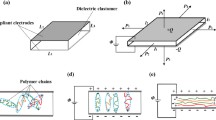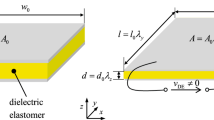Abstract
When a stretched elastomer is laminated to a flat plastic frame, a complex shape is formed, which is termed a minimum-energy structure. It is shown how self-organized structures can be applied in the development of actuators with complex, out-of-plane actuationmodes. This unusual concept is then demonstrated in the case of dielectric elastomer actuators. Among advantages of this approach are the simplicity in manufacturing, the potential complexity and sophistication of the manufactured structures, and the general benefits of the concept when applied to other electro-mechanically active materials.
Similar content being viewed by others
References
Y. Bar-Cohen (ed.), Electroactive Polymer (EAP) Actuators as Artificial Muscles: Reality, Potential, and Challenges (International Society for Optical Engineering (SPIE), Bellingham, Washington, 2004)
Q. Pei, R. Pelrine, S. Stanford, R.D. Kornbluh, M.S. Rosenthal, Synth. Met. 135–136, 129 (2003)
H. Prahlad, R. Kornbluh, R. Pelrine, S. Stanford, J. Eckerle, S. Oh, Polymer power: dielectric elastomers and their applications in distributed actuation and power generation. In Proc. ISSS 2005, Bangalore, India, 2005, SA-13
L. Treloar, The Physics of Rubber Elasticity (Oxford Classic Texts Phys. Sci.) (Oxford University Press, Oxford, 2005)
R. Osserman (ed.), Geometry V, vol. 90 of Encyclopaedia of Mathematical Sciences (Springer, Berlin, 1997)
S. Hildebrandt, A. Tromba, The Parsimonious Universe: Shape and Form in the Natural World (Copernicus/Springer, New York, 1996)
J.M. Skotheim, L. Mahadevan, Science 308, 1308 (2005)
R. Pelrine, R. Kornbluh, Q. Pei, J. Joseph, Science 287, 836 (2000)
E.W.H. Jager, O. Inganas, I. Lundstrom, Science 288, 2335 (2000)
A.R. Tajbakhsh, E.M. Terentjev, Eur. Phys. J. E 6, 181 (2001)
Q.M. Zhang, H. Li, M. Poh, F. Xia, Z. Cheng, H. Xu, C. Huang, Nature 419, 284 (2002)
Author information
Authors and Affiliations
Corresponding author
Additional information
PACS
46.32.+x; 77.65.-j; 83.80.Va
Rights and permissions
About this article
Cite this article
Kofod, G., Paajanen, M. & Bauer, S. Self-organized minimum-energy structures for dielectric elastomer actuators. Appl. Phys. A 85, 141–143 (2006). https://doi.org/10.1007/s00339-006-3680-3
Received:
Accepted:
Published:
Issue Date:
DOI: https://doi.org/10.1007/s00339-006-3680-3




